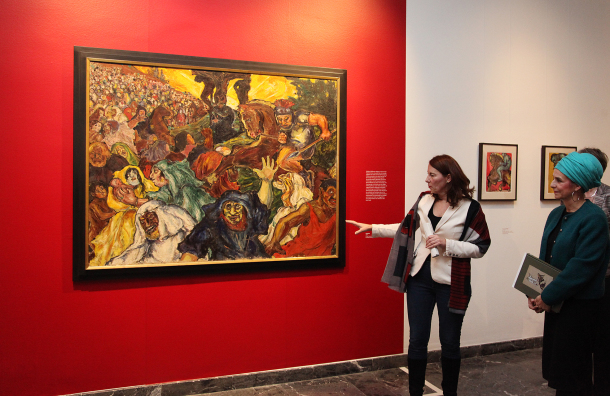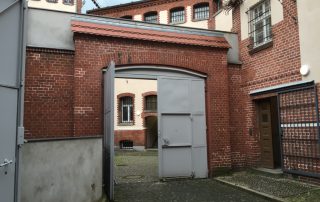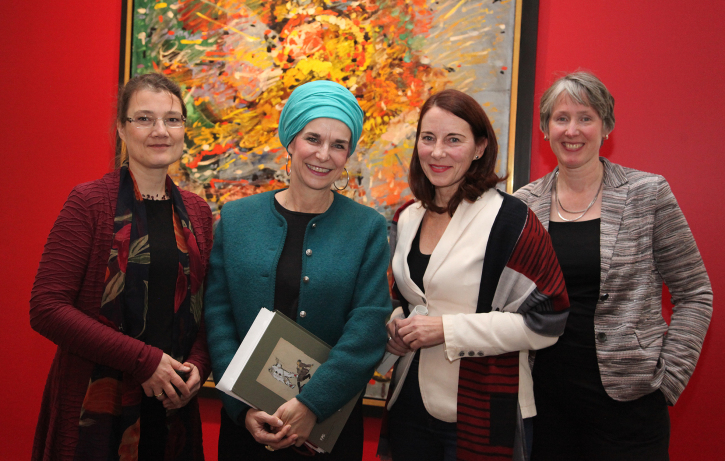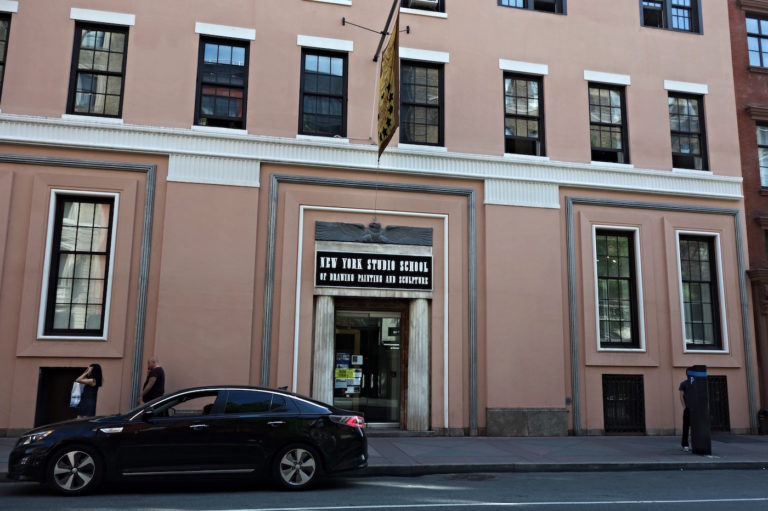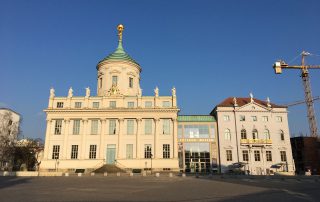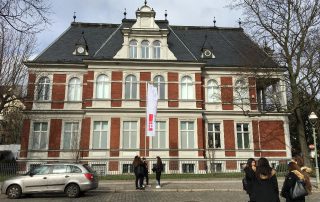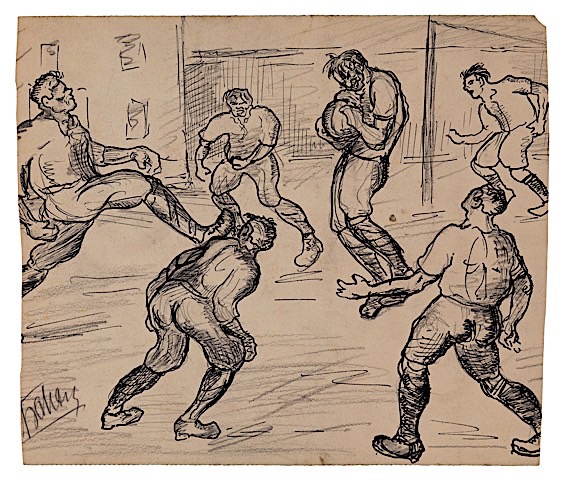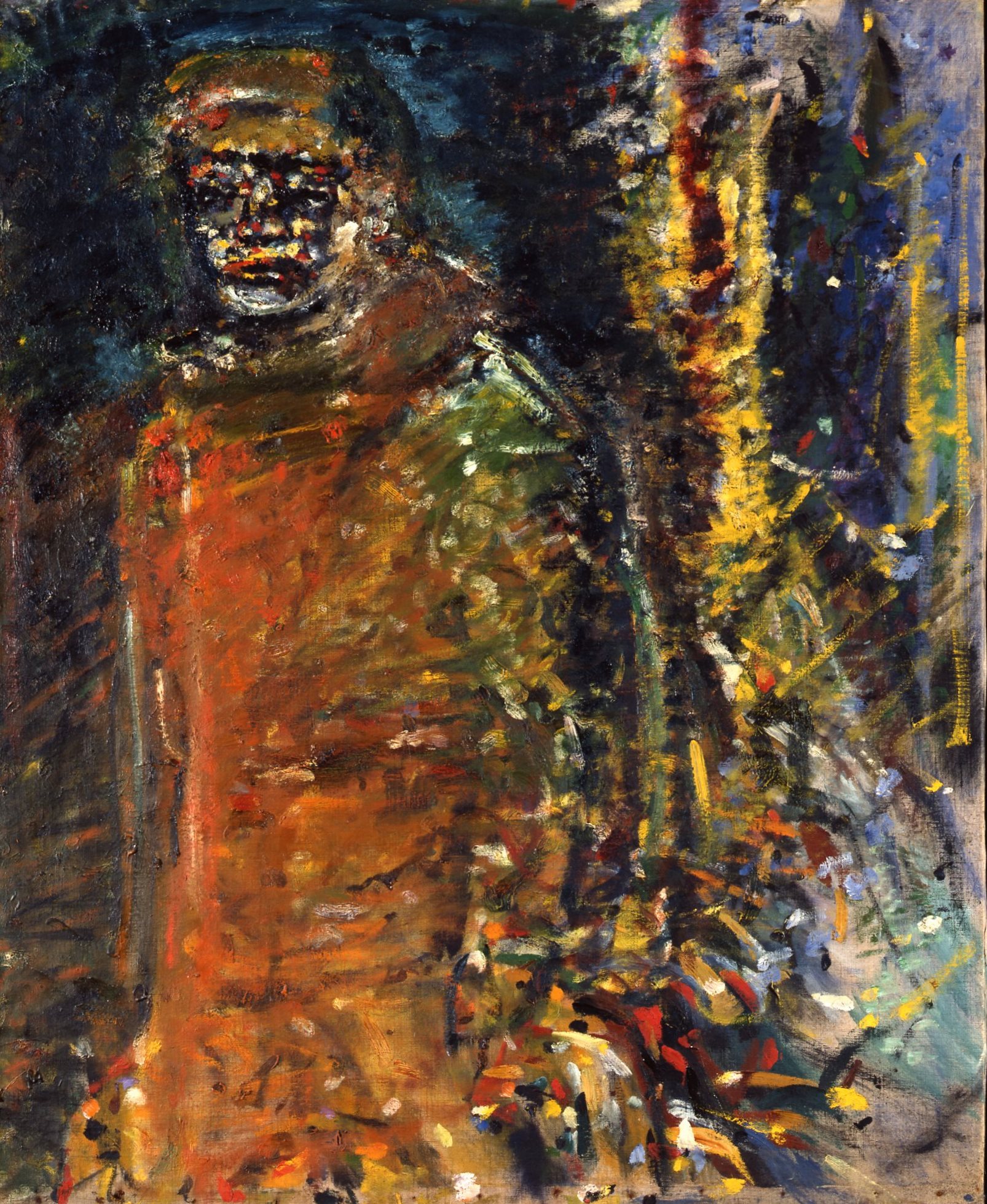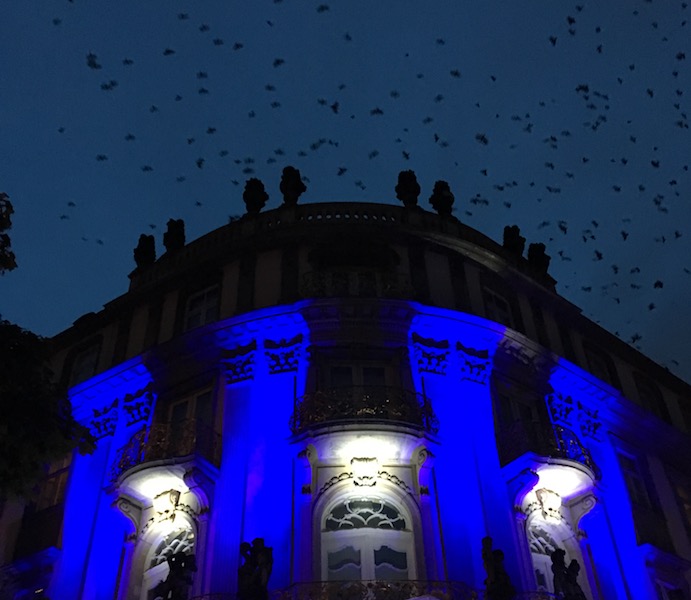Rachel Stern2018-12-04T12:07:01-05:00December 25th, 2017|Select Press Coverage|
Ein Zerrissener Das Potsdam Museum entdeckt Fritz Ascher, der sich in Potsdam vor den Nazis versteckte by Lena Schneider Wer war Fritz Ascher? Das Potsdam Museum hat diesem Unbekannten eine Sonderausstellung gewidmet. „Leben ist glühn“ heißt sie. Ein Bild, das hier hängt, kann man als bestürzende Antwort auf die Frage lesen. „Bajazzo“ heißt es, nach dem italienischen Bruder des Harlekin. Zu sehen ist eine schemenhafte Gestalt, in gelbem Kostüm. Im weiß geschminkten Gesicht ist so etwas wie ein trostloser Schatten des Clownsgenres auszumachen: schwarze Augen, die rot überzogen Mundwinkel krümmen sich nach unten. Das ganze Bild ist wie zerschossen von Farbpunkten. Die Antwort darauf, wer Fritz Ascher, geboren 1893 als Kind jüdischer Eltern, war, findet sich im Entstehungsdatum des Bildes: [...]
Rachel Stern2018-12-13T19:05:14-05:00December 22nd, 2017|Exhibitions, Past Exhibitions|
Stiftung Gedenkstätte Lindenstrasse in Potsdam examines for the first time the history of the Potsdam police prison, the prison where Fritz Ascher spent almost 5 months in 1939. When the prison building in what is today Henning-von-Tresckow-Strasse was torn down in 2002, Potsdam historian Hannes Wittenberg was able to save two original artefacts, both today in the collection of the Potsdam Museum: an original prison door and a model of the prison building built by prisoners in the 1980s for fire protection exercises. Both objects are on display in the exhibition, together with original photographs and documents of the prison building. Fritz Ascher is one of the former prisoners, whose biography is being told. (website link) Questions being asked in [...]
Rachel Stern2018-12-04T12:14:23-05:00December 22nd, 2017|Newsletter|
Dear Friends, I am humbled and honored to have received the Lea and Hans Grundig Prize for my work about Fritz Ascher. Right on time for his 125th birthday, the Fritz Ascher retrospective is now open in Berlin and Potsdam, the two places where the artist lived and worked. Museum Charlottenburg-Wilmersdorf in der Villa Oppenheim in Berlin exhibits an overview of the artist’s creative development, with a focus on works that relate to Berlin. We see his sketch of the artist Max Liebermann as well as his love for music and performance in Weimar Republic paintings like “Beethoven” and “Bajazzo and Artists”. After surviving the Nazi terror regime in hiding in the Berlin Grunewald neighborhood, he painted these works over [...]
Rachel Stern2018-12-04T12:15:18-05:00December 21st, 2017|Newsletter|
Dear Friends, Today I am excited to share with you some photos of last week’s opening of “Beauteous Strivings: Fritz Ascher, Works on Paper”, which is on view at the New York Studio School daily 10:00am-6:00pm until December 3 (website link). In this exhibition, “powerful emotions seem to lurk just beneath the apparent directness and economy of the tree and flower paintings” of the 1950s and 1960s, observes curator Karen Wilkin in the catalogue that accompanies the exhibition. She continues: “A sense of near-obsession, of ferocious concentration, of focus that excluded everything else, was palpable, made visible in the traces of his rapidly moving hand, driving across the paper, making loops and whorls, and then abruptly changing direction. At the [...]
Rachel Stern2018-12-03T16:06:56-05:00December 10th, 2017|Exhibitions, Past Exhibitions|
Coming home: With more than 80 paintings and works on paper, the worldwide first Fritz Ascher Retrospective is on view at the places where Fritz Ascher lived and worked, with parallel exhibitions in Berlin and Potsdam. Each venue shows a representative group of powerful paintings and drawings, which span Ascher's whole oeuvre from first academic studies to monumental Expressionist figure compositions to late landscapes. Both venues present Fritz Ascher's poems, written while hiding from Nazi persecution, as "unpainted paintings" in relation to his artwork. The Potsdam Museum shows Ascher’s artistic development in four galleries, starting with early masterworks like the monumental “Golgotha” and “The Tortured”. The second gallery shows Ascher’s love for music and stage and for the Clown theme [...]
Rachel Stern2018-12-03T16:06:56-05:00December 8th, 2017|Exhibitions, Past Exhibitions|
Coming home: With more than 80 paintings and works on paper, the worldwide first Fritz Ascher Retrospective is on view at the places where Fritz Ascher lived and worked, with parallel exhibitions in Berlin and Potsdam. Each venue shows a representative group of powerful paintings and drawings, which span Ascher's whole oeuvre from first academic studies to monumental Expressionist figure compositions to late landscapes. Both venues present Fritz Ascher's poems, written while hiding from Nazi persecution, as "unpainted paintings" in relation to his artwork. In Berlin, Museum Charlottenburg-Wilmersdorf in der Villa Oppenheim shows an overview of the artist’s creative development, with a focus on works that relate to Berlin. We see his sketch of the artist Max Liebermann as [...]
Rachel Stern2018-12-04T12:26:37-05:00September 17th, 2017|Select Press Coverage|
Der Gezeichnete Sven Goldmann Gefördert von Max Liebermann, geschätzt wie Grosz, Dix und Heartfield – doch es bedurfte des 125. Hertha-Geburtstages, um dem Maler Fritz Ascher neue Aufmerksamkeit zu verschaffen. Schwarze Tusche und Grafit auf Papier: „Fußball konnte er also auch malen.“ Verena Veldes Augen huschen über den Ausstellungskatalog, „Leben ist Glühn“, Abbildung 37 auf Seite 202. Eine Zeichnung mit sechs kräftigen Burschen in knielangen Hosen. Einer kommt von links mit kräftigem Spreizschritt herangestürmt, zu spät, der Ball befindet sich schon in den Händen des Torhüters, der drückt ihn zugleich zärtlich und energisch an sich. Konzentriertes Schweigen am anderen Ende des Tisches. So sah Fußball vor 100 Jahren aus – gar nicht so viel anders als heute. „Gefällt mir“, sagt [...]
Rachel Stern2018-12-04T12:27:33-05:00September 17th, 2017|Select Press Coverage|
Kunststück Wiebke Hölzer Die Masse stürmte um ihn her. / Starr, stumm, in sich blieb er versunken.« So beginnt das von dem Berliner Künstler Fritz Ascher verfasste Gedicht »Bajazzo«. Die Zeilen umschreiben treffend das Sichtbare auf seinem gleichnamigen Ölgemälde: Starr und wie in einem Sturm aus farbigen Pinselstrichen schreitet der Bajazzo, also die italienische Clownsfigur, nach links gewandt von einer abstrakt gehaltenen Umgebung ins Dunkel. Als erste Körperform nimmt der Betrachter den Kopf wahr, während der Rest des Körpers mit dem Hintergrund verschmilzt. Zwar reduziert Ascher die Mimik der Figur, aber gestaltet sie gleichzeitig ausdrucksstark - der Mund vermittelt das Gefühl von Traurigkeit und die Augen in Form schwarzer Höhlen symbolisieren als Spiegel der Seele das leere, einsame Innere. Die [...]
Rachel Stern2018-12-21T06:00:22-05:00September 17th, 2017|Selected Publications|
Wiebke Hölzer. Fritz Ascher. Biographisch-Bibliographisches Kirchenlexikon (BBKL), vol. 38, Nordhausen: Verlag Traugott Bautz GmbH. pp. 66-71 Download PDF Geboren am 17.10.1893 in Berlin, gestorben am 26.03.1970 in Berlin; expressionistischer Maler und Grafiker, Dichter. Er wuchs als Sohn der jüdisch assimilierten Eltern Hugo Ascher (27.7.1859-18.08.1922) und Minna Luise Ascher, geb. Schneider (17.01.1867-17.10.1938) zusammen mit seinen zwei jüngeren Schwestern Charlotte (08.10.1894-06.12.1978) und Margarete (11.06.1897-15.01.1973) auf. 1899 trat Hugo Ascher mit seinen Kindern aus dem Judentum aus und ließ Fritz 1901 evangelisch taufen. Sein Vater war durch die Entwicklung von künstlichem Zahnschmelz zu Wohlstand gekommen und konnte somit Wohnungen in der Friedrichstraße und der Jägerstraße und später den Bau einer Villa in der Niklasstraße in Zehlendorf finanzieren. 1909 besuchte Ascher — durch das [...]
Rachel Stern2018-12-04T12:33:00-05:00September 1st, 2017|Newsletter|
Dear Friends, It was fun to attend the opening of “Hauptstadtfussball” at the Ephraim Palais in Berlin, celebrating the 125th anniversary of the Berlin soccer club Herta BSC and its local rivals. I learned so many things about soccer in Berlin, and about Herta BSC in this creative, well researched exhibition. And you can see Fritz Ascher’s “Soccer Players” from c. 1916! It will be on view until January 8, 2018. link Thank you to Sven Goldmann for bringing Fritz Ascher alive in his full page piece in the German newspaper Der Tagesspiegel! link Here in New York, the preparations for “‘Beauteous Strivings.’ Fritz Ascher - Works on Paper” at the New York Studio School are in full swing. The New [...]
Rachel Stern2018-12-04T12:33:53-05:00July 10th, 2017|Newsletter|
Dear Friends, Time for the outdoors! What could be timelier than an exhibition about soccer. On July 26th, the Ephraim Palais in Berlin is opening “Hauptstadtfussball,” celebrating the 125th anniversary of the Berlin soccer club Herta BSC and its local rivals. In this exhibition, you can find Fritz Ascher’s “Soccer Players” from c. 1916! It will be on view until January 8, 2018: link Since the last newsletter, Wiebke Hölzer published two essays about Fritz Ascher, one in the Biographisch-Bibliografisches Kirchenlexikon (BBKL, vol. 38, Nordhausen 2017), and one called "Kunststück" examining his “Bajazzo” from 1924 in Weltkunst No. 129 from May 2017 (pp. 120-121). And our most accomplished lawyer, the author Nicholas O'Donnell, a veteran attorney and litigation partner at the [...]
Rachel Stern2018-12-04T12:34:52-05:00July 10th, 2017|Newsletter|
Dear Friends, Maybe today’s storm is finally bringing warm weather? Fritz Ascher wrote a poem about the strong winds that spring brings: SPRING WIND As power romps around in space; blustering, boiling, blustering. As it tugs at the clouds, - it rustles forest and fields. As willingly everything submits to this wild child. The field weighs Its life force - ; Winds, - Spring’s windlass! (Poems Vol. 1, undated, p. 42) Siegmund Rotstein, Rachel Stern and Dr. Ingrid Moessinger at the opening of the Fritz Ascher exhibition at the Kunstsammlungen Chemnitz - MUSEUM GUNZENHAUSER on March 4, 2017. At the Kunstsammlungen Chemnitz - MUSEUM GUNZENHAUSER, the Fritz Ascher Retrospective is still on view until June 18. It is the first [...]


